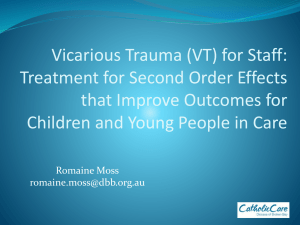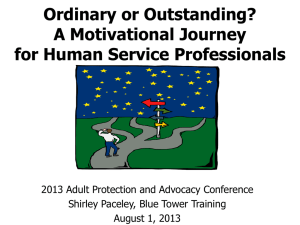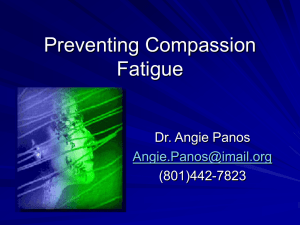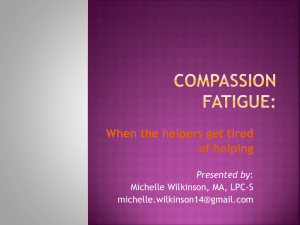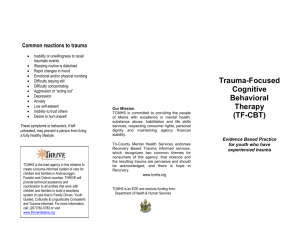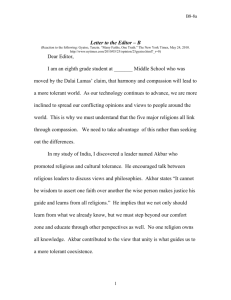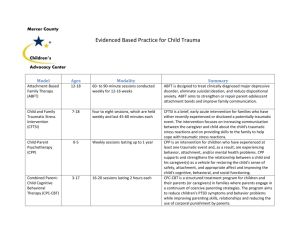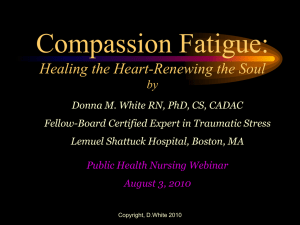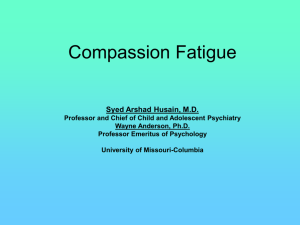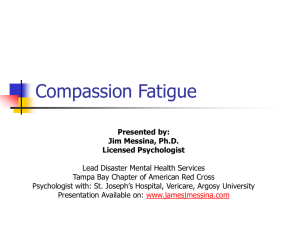Session 44 Pettinelli Handout 28k - Illinois Association of School
advertisement
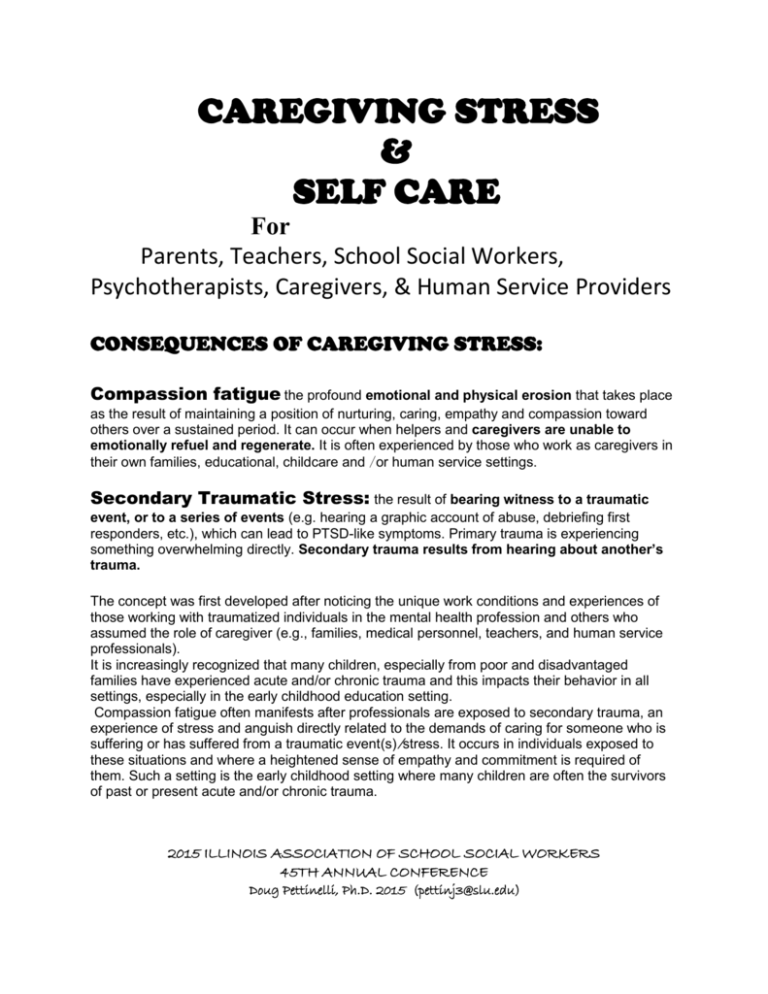
CAREGIVING STRESS & SELF CARE For Parents, Teachers, School Social Workers, Psychotherapists, Caregivers, & Human Service Providers CONSEQUENCES OF CAREGIVING STRESS: Compassion fatigue the profound emotional and physical erosion that takes place as the result of maintaining a position of nurturing, caring, empathy and compassion toward others over a sustained period. It can occur when helpers and caregivers are unable to emotionally refuel and regenerate. It is often experienced by those who work as caregivers in their own families, educational, childcare and ⁄or human service settings. Secondary Traumatic Stress: the result of bearing witness to a traumatic event, or to a series of events (e.g. hearing a graphic account of abuse, debriefing first responders, etc.), which can lead to PTSD-like symptoms. Primary trauma is experiencing something overwhelming directly. Secondary trauma results from hearing about another’s trauma. The concept was first developed after noticing the unique work conditions and experiences of those working with traumatized individuals in the mental health profession and others who assumed the role of caregiver (e.g., families, medical personnel, teachers, and human service professionals). It is increasingly recognized that many children, especially from poor and disadvantaged families have experienced acute and/or chronic trauma and this impacts their behavior in all settings, especially in the early childhood education setting. Compassion fatigue often manifests after professionals are exposed to secondary trauma, an experience of stress and anguish directly related to the demands of caring for someone who is suffering or has suffered from a traumatic event(s) ⁄stress. It occurs in individuals exposed to these situations and where a heightened sense of empathy and commitment is required of them. Such a setting is the early childhood setting where many children are often the survivors of past or present acute and/or chronic trauma. 2015 ILLINOIS ASSOCIATION OF SCHOOL SOCIAL WORKERS 45TH ANNUAL CONFERENCE Doug Pettinelli, Ph.D. 2015 (pettinj3@slu.edu) VICARIOUS TRAUMA: the transformation of our view of the world due to the cumulative exposure to traumatic images and stories. This is often accompanied by intrusive thoughts and imagery and difficulty ridding ourselves of the traumatic experiences recounted by children or those we care for. BURNOUT: fatigue, frustration, or apathy which is the result of prolonged stress, overwork, frustration or intense activity. (e.g. having poor pay, unrealistic demands, heavy workload, heavy shifts, poor management, and inadequate supervision). This happens in any occupation, not just those involved in caring for others. Work-family interface conflict refers to the mutual dependence between the domains of work and family. Stressors related to work-family interface manifest when either work demands or family demands become difficult to manage independent of one another. And these stresses do not demand the exercise of compassion or empathy. In contrast, compassion fatigue is not related to inter-role demands and is exclusive to caregivers. On the other hand, caregivers may be more vulnerable to experiencing stressors related to work-family interface due to the additional emotional demands required of the caregiver role Not unlike compassion fatigue, work-family interface conflict can have negative implications on overall psychological well-being and can be remedied by the increased practice of balancing work and family. COMPASSION SATISFACTION: the pleasure you derive from being able to do your work well. The above are descriptions of emotional/psychological states. As with any definition of an emotional/psychological state, the exact nature of the state will manifest itself within the context of each individual’s psychological, emotional, and interpersonal makeup, as well as being a function of the context of their life. Like snowflakes, human beings share common characteristics, but each individual is unique. Thus, the initial goal is to understand these states do occur. Second, we try to determine how they might manifest themselves in each of us in our own unique way. So all individuals may not have all the suggested symptoms or manifestations. 2015 ILLINOIS ASSOCIATION OF SCHOOL SOCIAL WORKERS 45TH ANNUAL CONFERENCE Doug Pettinelli, Ph.D. 2015 (pettinj3@slu.edu) Self-awareness and self-monitoring are essential for recognizing when changes in behavior or work life are needed Common signs of compassion fatigue include (a) (b) (c) (d) trouble sleeping, Chronic physical and emotional exhaustion emotional withdrawal increased emotional reactivity (i.e., irritability, anxiety, emotional reactivity both inside and outside of work setting (e) hypervigilance (f) loss of empathy, respect, and positive feelings for children (g) trouble detaching thoughts and feelings related to his or her students’ suffering from their own personal lives (h) diminished interest in regular activities (i) cognitive disturbances (memory difficulties, difficulty concentrating, etc.) (j) depersonalization (k) feelings of inequity (l) negative feelings toward work, life, and others outside the early childhood setting (m) feelings of self-contempt (n) feelings of low job satisfaction (o) psychosomatic problems PREVENTION/INTERVENTION I. REDUCING AND MANAGING STRESS IN THE WORK SETTING a. b. c. d. e. f. g. reducing caseloads cultivating formal supervisory relationships cultivating informal mentor relationships maintaining consistent levels of supervision taking regular vacations participating in educational retreats sustaining a balance between one’s personal and professional life is essential. II. STRENGTHENING SELF AWARENESS III. APPROACHES TO SELF CARE a. Monitoring physical health b. making time for spiritual practices c. meditation 2015 ILLINOIS ASSOCIATION OF SCHOOL SOCIAL WORKERS 45TH ANNUAL CONFERENCE Doug Pettinelli, Ph.D. 2015 (pettinj3@slu.edu) d. journaling e. yoga. A regimen of yoga is an affordable method used to enhance selfawareness, patterns of cognition, and a lifestyle that is beneficial to self-growth f. developing external support g. maintaining healthy and open communication with family and friends allows great emotional escapes from professional responsibilities h. being with friends also allows one to escape daily expectations of family and children i. Laughter and fun, whether with friends or family, Engaging in lighthearted conversation, watching comedy entertainment, j. practicing religion k. participating in noncompetitive activities or hobbies The overall idea is to: 1. reduce and manage stress 2. strengthen self awareness 3. monitor your physical, emotional and interpersonal functioning 4. build resiliency: increase relaxation, rest, exercise, play 5. be part of a world that does not mirror the classroom/school environment SUGGESTED READINGS: Francoise Mathieu (2012) The Compassion Fatigue Workbook, New York: Routledge Lipsky, L. & Burk, C. (2009) Trauma stewardship: An everyday guide to caring for self while caring for others. San Francisco: Berrett-Koehler Rothschild, B.(2006) Help for the helper: Self-care strategies for managing burnout and stress. New York: W.W. Norton Skovholt, T. & Trotter-Mathison, M.(2011) The resilient practioner: Burnout prevention and self care strategies for counselors, therapists, teachers, and health professionals. New York: Routledge. Bush, A.D.(2015) Simple Self-care for therapists: Restorative practices To weave through your workday. New York: W.W. Norton Siegel, D.(2007) The mindful brain: Reflection and attunement in the 2015 ILLINOIS ASSOCIATION OF SCHOOL SOCIAL WORKERS 45TH ANNUAL CONFERENCE Doug Pettinelli, Ph.D. 2015 (pettinj3@slu.edu) cultivation of well-being. 2015 ILLINOIS ASSOCIATION OF SCHOOL SOCIAL WORKERS 45TH ANNUAL CONFERENCE Doug Pettinelli, Ph.D. 2015 (pettinj3@slu.edu)

